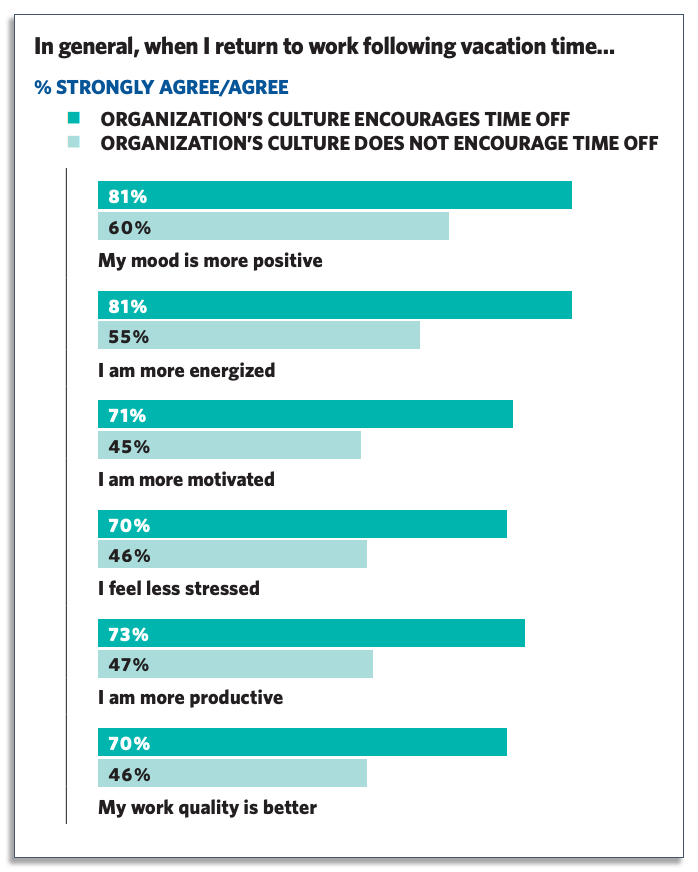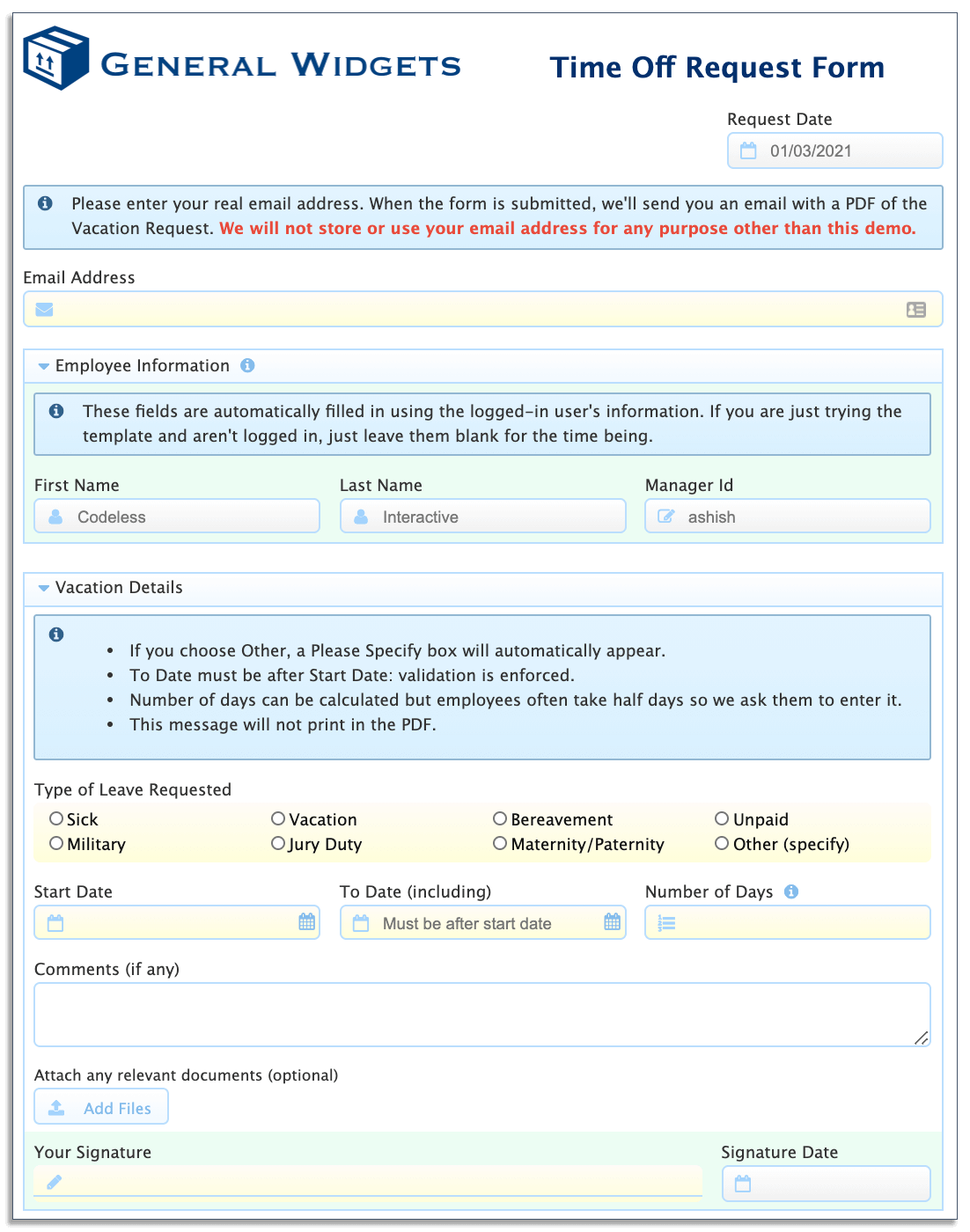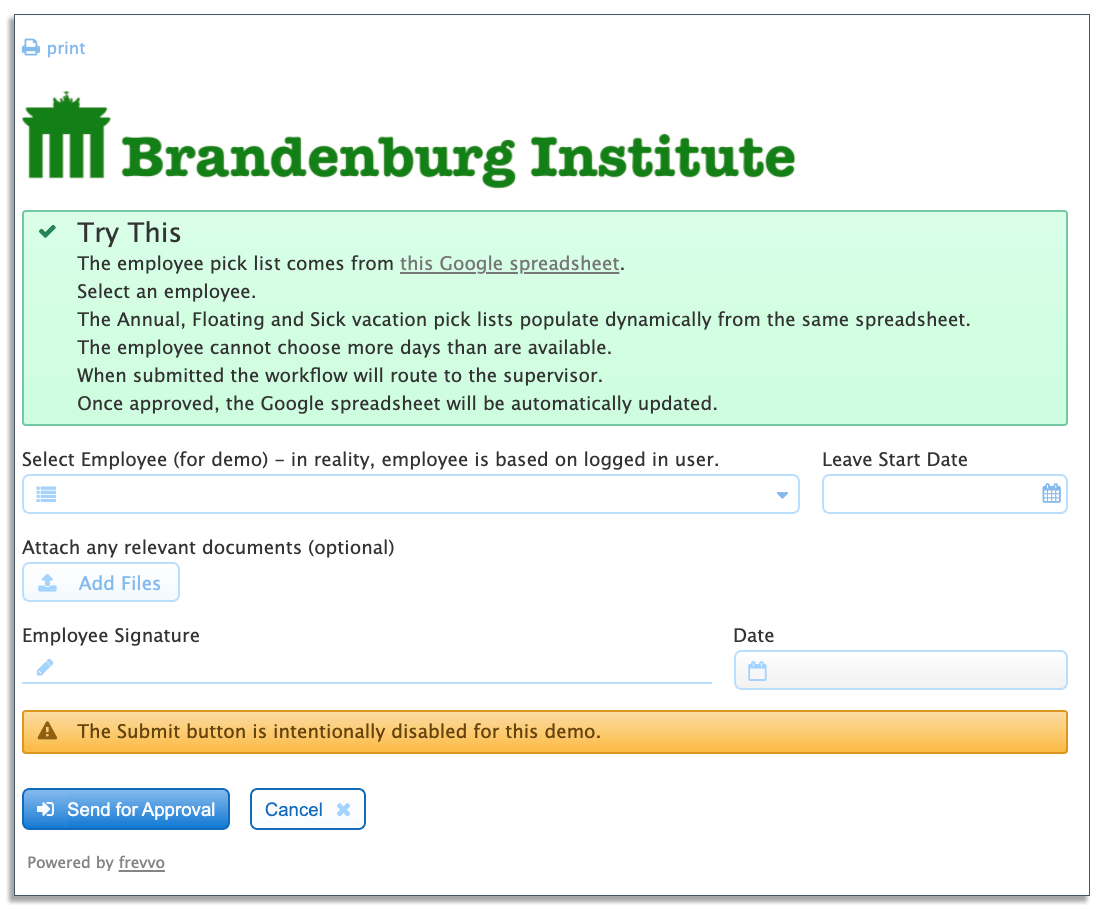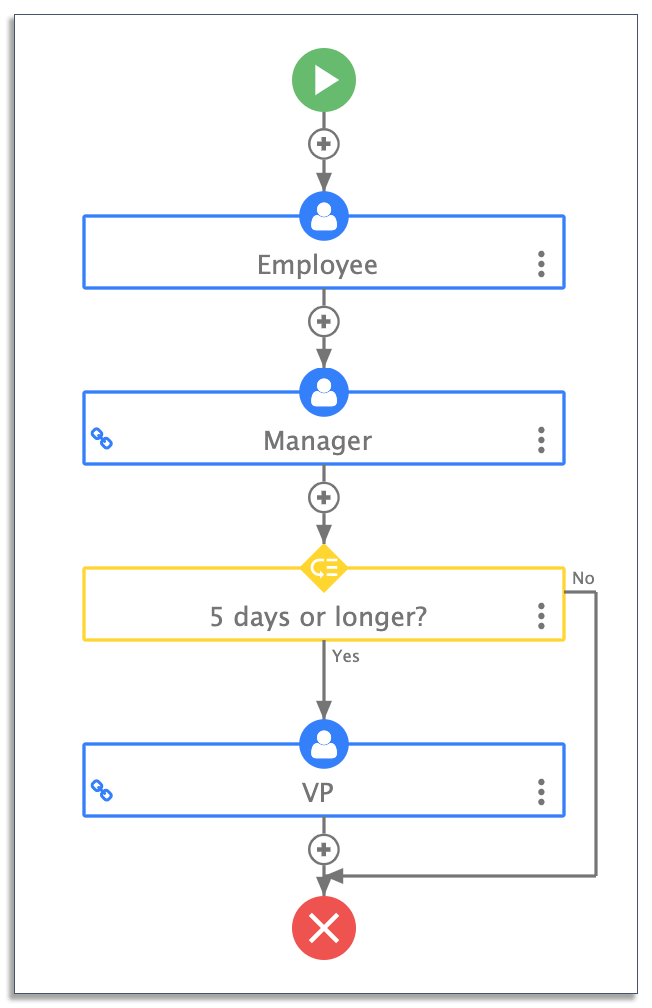
Employees that take vacations are more motivated and produce better quality work. It seems smart, then, to encourage your team to take days off to recuperate.
However, 6 out of 10 workers don’t feel like their employer encourages them to take time off.
While there are multiple reasons staff feel discouraged, a big problem lies in how vacation request processes are set up.
Employees get nervous about asking for time off in person. They’re worried about looking replaceable and uncommitted to their jobs, and this fear can stop them from asking for time off altogether.
To solve this, you need to make it easier for staff to ask for time off. Dynamic, digital vacation request workflows are the ideal way to do this.
Read on to discover why vacation time is so crucial to your team’s wellbeing and how to more effectively manage time-off requests.
Want to jump ahead? Click here to skip to the section that interests you most:
Why is Vacation Time Important for Teams?
Just like a car that needs to refuel, employees need vacation time to restore their energy levels. If employees aren’t taking this time to revitalize themselves, they run the risk of burnout.
The issue is that lots of employees aren’t taking their allotted vacation time. In fact, more than half of US workers report having unused vacation days.

Many say that this is because their workload is simply too heavy, while 61% say they fear that they’ll look replaceable to their superiors.
With plummeting unemployment rates, the very real fear of unemployment leaves employees scared to ask for vacation time.
But, when your team fails to take the break they need, you’ll start to see negative impacts on their work.
Studies show that employees who work when they’re meant to be taking time off feel less intrinsic motivation for their job than those who rest on their days off.
In other words, if you want a more motivated team, you need to let them rest.
Not only that, but those who use the majority of their vacation time have a better outlook toward their work.
Research shows that workers who use up more than 75% of their vacation allowance are happier with their company and their job than those who don’t.

In a more practical sense, vacations can help teams organize themselves better. Teams that know how to cover for each other and do so willingly are naturally more collaborative. Ultimately, if no individual is a single point of failure, it makes for a much stronger team.
After all, you might lose that individual permanently because they take a new job or relocate.
When they take time off, you’ll lose them temporarily. Let your team treat it as an opportunity to learn how to work together more effectively.
It could even be a welcome respite from their regular tasks so they can learn to do something different. It’s a win-win for all.
6 Ways to Make Managing Time-Off Requests Easier
If you want to inspire your team to take time off to recuperate, you need to create a time-off request process that makes it easy for them to book vacation days.
Here are six key tips for efficiently facilitating time-off requests.
1. Encourage Employees to Take Time Off
Since vacation time brings such valuable rewards to your organization, it’s in your best interest to encourage employees to take it.
Despite the benefits of employee leave, 60% of firms don’t encourage employees to take vacations.
This leads to a negative feeling around vacation time, with a quarter of workers admitting that they feel guilty when they take time off. On top of that, one in five workers is frightened that they’ll seem less committed to their job if they take a vacation.
But here’s the kicker.

Employees that feel like their company encourages vacation time return to work feeling more positive, energized, motivated, and productive. They’re also less stressed, and their quality of work is higher than those who don’t feel that their company is supportive about taking time off.
That’s why it’s important that you encourage workers to take a vacation.
As Paul McDonald, Senior Executive Director of Robert Half, the world’s largest staffing firm, put it, “Managers should encourage employees to fully disconnect from work to focus on themselves and family and avoid burnout.”
This encouragement starts at the top.
Whether you’re the CEO of the organization or the leader of a small team, it’s important to set the proper tone.
Don’t just pay lip service to the “vacations are important” idea. If you’re promoting and encouraging employees to take breaks but neglecting to take time off yourself, you have the opposite effect.
If people see that you’re not taking breaks, they get anxious and start thinking that the only way to keep their job or get that promotion is to put in long hours without ever taking a vacation.
Don’t just support work-life balance for your staff; live it. You’ll be happier, your family will thank you, and your staff will be better off knowing that you truly mean what you say.
What’s more, as a team leader, you should foster a culture of taking periodic time off and shut down negative comments like “Lucky you! I wish I wasn’t too busy to take a vacation”.
Beware of rewarding employees for not taking time off. Rewards for performance, delivering on time, exceeding client expectations are all fine but never explicitly reward the no-vacation-warrior. It sets the wrong tone and expectation in your team.
Finally, make it clear that you don’t expect people to “be available” while on vacation. It’s insidious and again creates the expectation that work preempts all.
Time off should be a break — resist the urge to reply to emails when you’re taking a break yourself. Trust your team to take care of things — after all, that’s why you hired them.
2. Don’t Judge How People Spend Their Vacation
Everyone is different — some people want to go relax at their favorite beach resort, while others might just want to kick back at home.
Some people may feel that it’s not worth taking vacation days if they’re just going to sit at home. Often, other co-workers and bosses add to this pressure with personal judgments on how team members spend their vacation time.
However, Ellie Green, jobs expert at Totaljobs, stresses the importance of taking care of mental wellbeing, advising workers: “If that means using up some of your holiday allowance and doing what you can to relax or do something you enjoy at home — you can.”
As a manager, it’s not your job to interfere or judge what’s best for employees. Tell them to take the time to rejuvenate themselves and come back refreshed and ready to tackle future challenges.
3. Establish a Clear PTO Policy and Write it Down
It’s vital that you have a clear paid-time-off (PTO) policy so that staff know the process for taking leave.
You need to establish the rules around time off and how it works. You also need to communicate the protocols for applying for time off.
When creating rules around vacation time, you need to consider the boundaries for your team members, so they know when and how often it’s appropriate to ask for vacation.

Consider these thoughts:
- How often can staff request time off?
- How close together can periods of vacation leave be?
- What is the maximum number of days that employees can take off in a row?
- Are there any particular dates of the year that staff can’t take time off?
- Are there any dates which staff must take off, such as major holidays?
- Can a staff member make multiple requests at once?
- How will you communicate this leave policy?
Next, think about the process that employees must go through to request time off and how you communicate this.
Ask yourself:
- Who should employees speak to?
- What documentation do they fill out?
- When should requests be submitted?
- Who needs to approve requests?
- How will you communicate this process?
4. Consider Making it a Team Exercise
Sure, you as the leader of the team might have the last word on approval, but employees are more likely to step up and be flexible if they know that they’re solving problems jointly as a team.
The message should be that you encourage and value breaks from work and that you want everyone to truly unplug while on vacation.
For example, “Let’s sit down and collectively figure out how we schedule vacation so that we don’t have overlapping requests. Equally, how can we cover for each other so that the person who’s off doesn’t have to monitor email and can genuinely break off from work?”
People will feel better knowing that colleagues have their back and are less likely to be resentful when others take a longer bucket list vacation or dream trip.
5. Digitize Vacation Requests
Consider digitizing your PTO request workflow to streamline the process.
With vacation request management software like frevvo, you can create a dynamic, mobile-ready, online time off request form that enables your staff to complete vacation requests from any device.
You don’t need to reinvent the wheel — simply use an existing request form template to create your dynamic PTO request form and vacation approval workflow.
By integrating these forms with your current HR systems, you can automatically pull data from existing databases. This speeds up the process and helps prevent errors.

These holiday requests are automatically routed to approvers, who can electronically sign the forms. This avoids delays and unnecessary frustration.
There’s no need for any manual printing, signing, or scanning for signatures, nor does the staff member have to email it manually.
For example, check out this Employee Leave Request form — it uses a Google Sheet to reduce data entry.

It has a dynamic picklist, pulls available vacation days dynamically from the sheet, and validates them. The user can also sign electronically.
You can also integrate a Google Sheet with a frevvo form or process for dynamic behavior.
To make the process quicker and more accurate, forms auto-populate with relevant data, such as sick, annual, and floating paid-time-off days. Automatic validation makes sure that users can’t make data entry mistakes.
As you can see, by digitizing the process with this dynamic form, requesting time off is quicker, easier, and less prone to error.
6. Automate the Process to Remove Friction
Work [and life] is already pretty stressful. Employee leave is meant for renewal and wellness, and you want employees to unplug. The last thing you want is for them to start their vacation on a frustrating note by dealing with a tedious and confusing process for requesting time off and getting it approved.
Worse, you definitely don’t want them wasting time at work.
Time-off requests usually require formal approval from a manager (even if you’re handling them as a team) and data entry by the HR team.
When employees are chasing down managers for signature and HR is manually performing data entry into internal systems, they aren’t spending time on the things you hired them for.
Automate the entire process with a modern, visual platform like frevvo that features vacation request management software.
With frevvo, you create fully automated vacation request workflows that can be accessed from any device.
This enables you to configure complex automatic routing, so request forms head straight to the appropriate approver. This means staff can request time off from anywhere — without having to run back-and-forth to the human resource department.

Approvers will automatically receive a notification of a travel request, which they can sign online with an e-signature. If approvers forget to sign, they’ll be sent an automatic reminder so that all vacation requests are approved on time.
Not only will automated cloud-based vacation request processes make it easier for staff and approvers, automatic validation and system integration means that there are fewer data entry errors.
Whether you’re starting from scratch or integrating an existing process, frevvo is straightforward to implement and easy to use.
This means staff can feel confident that their vacation plans are confirmed, so they’re better able to focus on the things that matter while at work.
Automate Your Time-Off Request Process Now
If you want a truly motivated and productive team that produces top-notch work all year round, you need to make sure you’re encouraging staff to take vacation days.
The problem is that if your leave management process is clunky, the team may feel discouraged from applying for time off. Properly managing time-off requests is the best way to facilitate a better vacation culture within your firm.
To streamline your time-off request process, digitize and automate your workflows with frevvo. Try the 30-day free trial now to see just how much easier managing time-off requests can be.




